Wednesday, October 1, 2003
It rained pretty hard early this morning, but by the time we got
up, it was bright and sunny and beautiful. At first I thought the
hotel people were being pretty chintzy with the complimentary
coffee, giving us the smallest coffee cups in the world, until Tom
informed me that, duh, it's expresso. I'm not a big fan of
expresso, but I drank two cups anyway, and I was ready to jump over
the building from the caffeine jolt.
Okay, yesterday we just had a short drive from the airport to
our hotel, so today would be the first real test of our mettle. Do
we have what it takes to drive with the locals? Tom unanimously
elects me to drive first, and off we go. If you wait till you have
enough space to pull out and get to speed before the next car
comes, you'll never leave your parking space. The other drivers
expect you to be bold. So you just wait for a space big enough that
you can nose out and give the oncoming traffic time to slow for
you, and then go for it! I had a little trouble in San Juan
determining what was a lane and what was not, then I realized that
if it was a wide enough space to fit your car into, drive there. I
drove aggressively, and it worked out fine.
We got off the Highway 22 toll road at Vega Baja and headed for
the coast. While enjoying the seclusion at the first playa (beach),
Tom realized he'd left his phone at the hotel. He used my phone to
call about it and arranged to collect it at the end of the trip
when we return to San Juan. Who wants a cell phone when they're on
vacation anyway?
The coast from Vega Baja to the outskirts of Arecibo is GORGEOUS
and practically deserted. It's not built up with resorts, and we
rarely saw another person on the beach. Paradise. We drove by the
Reserva Natural Laguna Tortuguero, home of the cayman alligator,
but we didn't see any. We really didn't want to venture too far off
the road though, in case they were lurking!
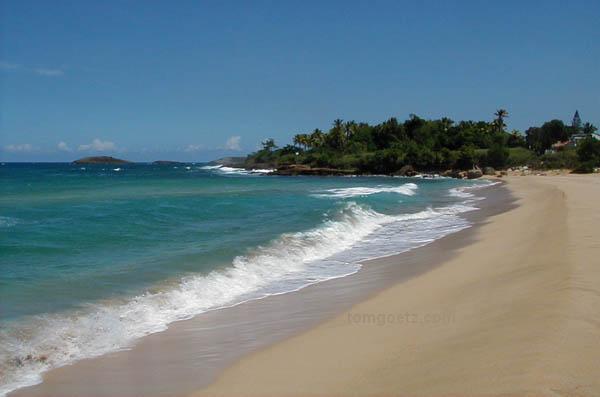
Secluded playa
Then we entered "Karst Country," a large area of the island
consisting of irregular limestone in which erosion from an
underground river system has produced mogotes (conical or
"haystack" hills), sumideros (sinkholes), underground streams, and
caverns. This is all made even more dramatic by the flora of the
area, which covers the geological formations with a lush tropical
forest. It's very "Lost World." Tom kept expecting a dinosaur to
appear around every bend.
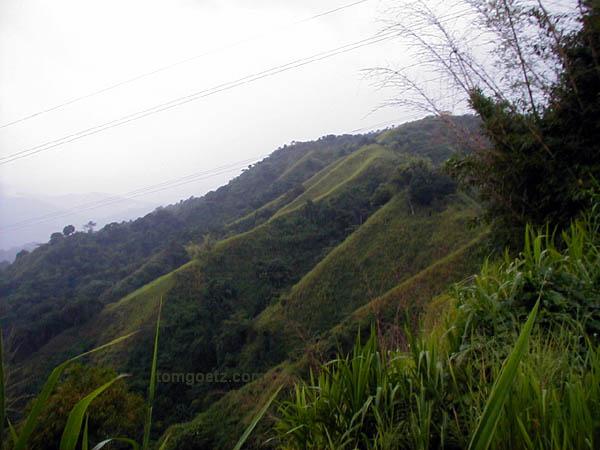
Undulating hills of karst country
In the midst of this karst topography is located the National
Astronomy and Ionosphere Center Observatorio de Arecibo, the
location of the largest radio telescope on earth, completed in
1963. Admission $4. The telescope dish itself is 1000 feet in
diameter, 167 feet deep, covers 20 acres, and is set in a sinkhole
between some hills. It is made of 40,000 3x6-foot aluminum panels.
The transmitting and receiving instruments are suspended some 450
feet above the dish and weigh more than 900 tons. The dish itself
weighs over 300 tons. Thirty-nine steel cables hold all this up,
each one weighing approximately ten tons. There are signs posted
throughout the facility prohibiting the use of cell phones,
explaining that the signal from your phone is BILLIONS of times
stronger than the signals they are trying to detect from space!
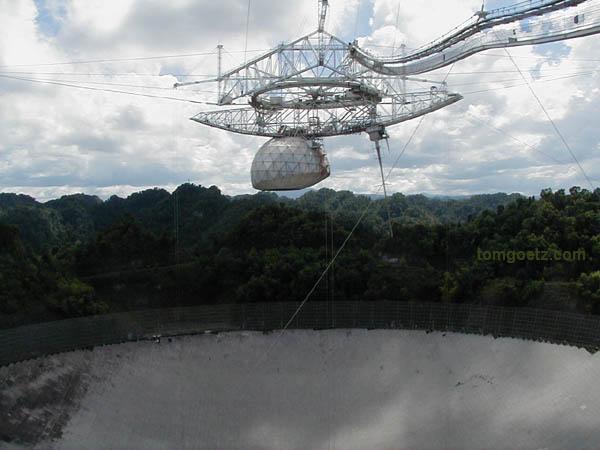
Arecibo radio telescope
Scientists have used this facility to study pulsars and quasars
and other known phenomena, as well as being the home of the
better-known SETI (Search for Extraterrestrial Intelligence)
program you might be familiar with from the Jodie Foster movie
"Contact" or the Charlie Sheen movie "The Arrival." The telescope
was also featured in James Bond's "Goldeneye," although they
inaccurately identified the telescope as being in Cuba rather than
Puerto Rico. If you visit Puerto Rico, you've gotta see this. It's
out of this world!
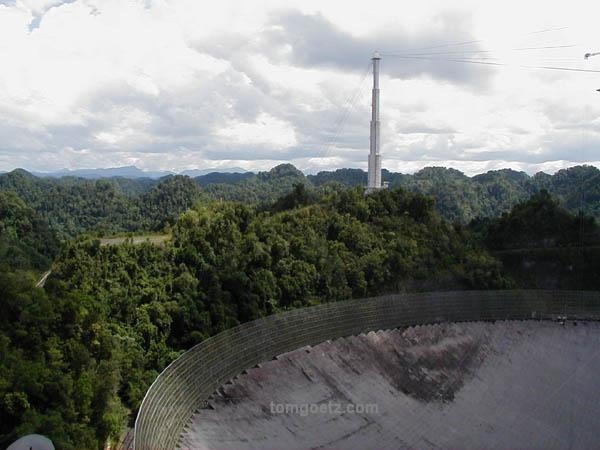
Phone home
Leaving the observatory, I informed Tom it was his turn to
drive. Between my navigating and his driving, we immediately got
lost in the roller-coaster ride of hills and thick forest, and I
immediately became carsick. We switched back at our next stop, and
I drove while he navigated for pretty much the remainder of our
trip.
We shortly arrived at the Parque de las Cavernas del Río Camuy
(Camuy River Cave Park), home to one of the largest cave systems
and the third-largest underground river in the world. Admission and
guided tour in English or Spanish $10. There are an estimated 1000
caves in Puerto Rico, only around 200 or so having been explored.
After a short video, you take a trolly (painted in Tennessee
orange, by the way) down into a large sinkhole to the entrance of
the main cave, Cueva Clara de Empalme (Clear Cave Junction), where
you take a 45-minute walking tour through the cave. We entered an
enormous cavern, open on both ends, the highest point of which
reaches 170 feet. Natural light shines in the entrances, so there
are ferns quite a ways into the cave. Very cool. In an adjacent
room you can see the the Río Camuy rushing through the cave. Cueva
Clara is home to 150,000 bats, but we didn't go into the batcave
portion so as to not disturb them, which suited me fine.
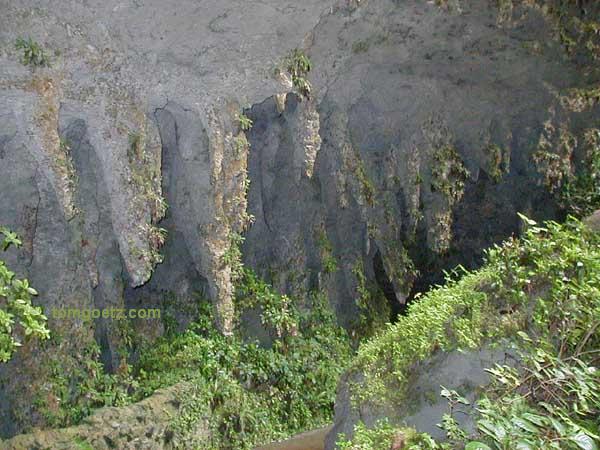
Eons-old stalagmites
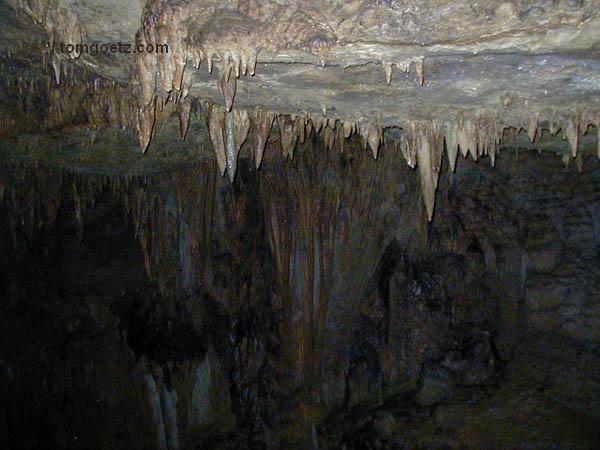
Inside Cueva Clara
After Cueva Clara, you reboard the trolley to the Tres Pueblas
sinkhole, measuring 650 feet across and 400 feet deep. You just
view it from the edge. Then you ride over to Spiral Cave, and it's
about a 20-minute optional walk down and back up 205 steps to this
one. Some people stayed on the trolley. We recommend you make the
walk. It is very weird looking.
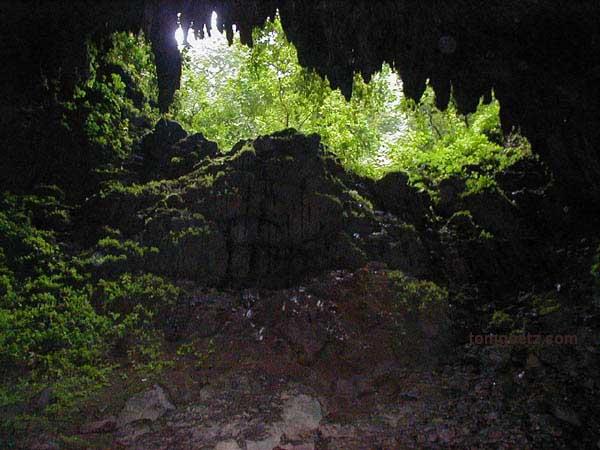
Looking out Cueva Clara
While we were touring the site, it started to thunder loudly,
the thunder echoing ominously in the cavern. We totally lucked out
not having it rain during our visit, but it began raining
immediately thereafter. We continued our driving tour to Lagos Dos
Bocas. On our way there we drove through the mountain town of
Utuado, where my dad and his wife and my niece Stephanie went on a
mission trip a couple of years ago with the Methodist Church. By
the time we got to Lagos Dos Bocas, it was pouring, but I'm sure it
would be very pretty in the sunshine.
We headed out of the mountains and towards the coast to find a
bed for the night. First we tried Arecibo. It had stopped raining
by now, and Arecibo has a nice malecón. We would have liked to have
explored the town, but our guidebooks didn't list any hotels there,
and we weren't able to find any just by randomly driving around, so
we headed further west. We were aiming for a couple of known
paradors, when suddenly Tom the navigator sent me off the highway
to drive through the communities of Hatillo and Camuy. By now night
had fallen, we were off the beaten path, and the streets were DARK.
I drove along the dark, narrow roads the best I could, occasionally
having to veer out of the way of an oncoming horse. We didn't find
a hotel here, and I was glad to return to the highway.
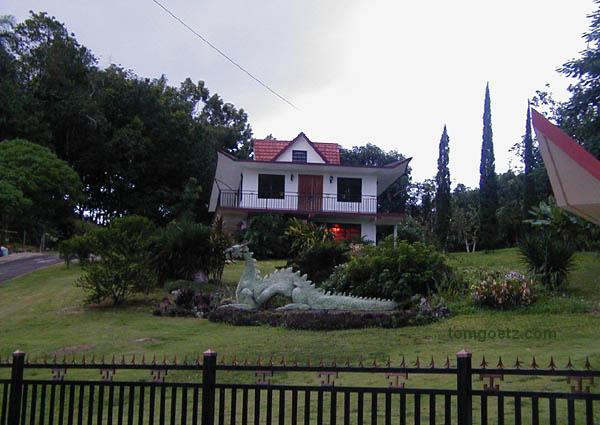
An unexpected sight
We wound up with a room in Quebradillas at the Parador Vistamar,
$69 for a room without a view. For 20 more bucks we could get a
room with a view of the ocean, but since it was dark, who cares?
Pizza is evidently the national food of the commonwealth of Puerto
Rico, and there's a pizza joint on almost ever corner. So we did
like the locals and had dinner at Pizza Hut! Afterwards, I spent
the evening sitting on the balcony reading and listing to the coquí
frogs, indigenous to Puerto Rico, while Tom spent the evening
watching "Blind Date." Puerto Rico must be rotting his brain.
|







